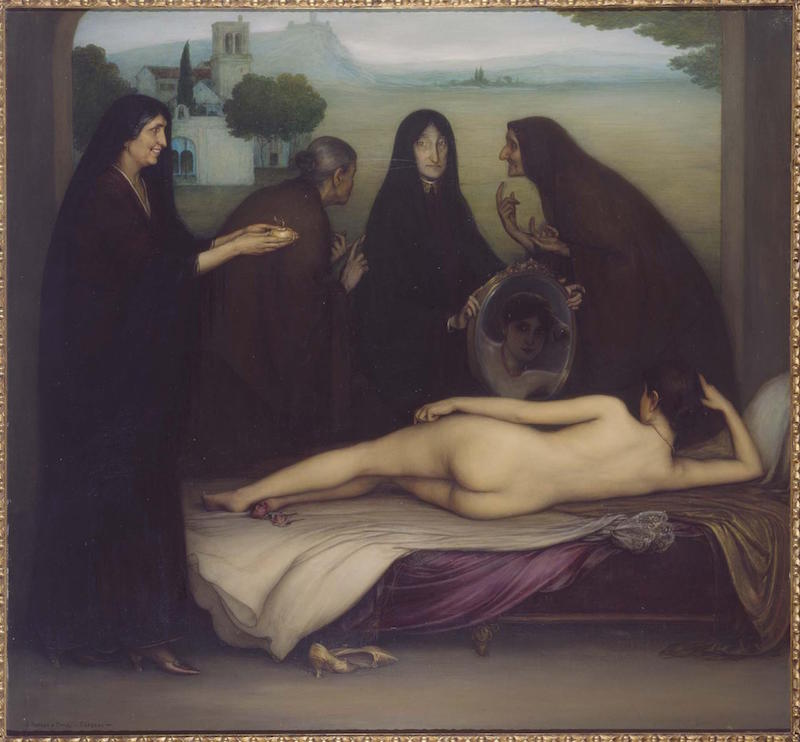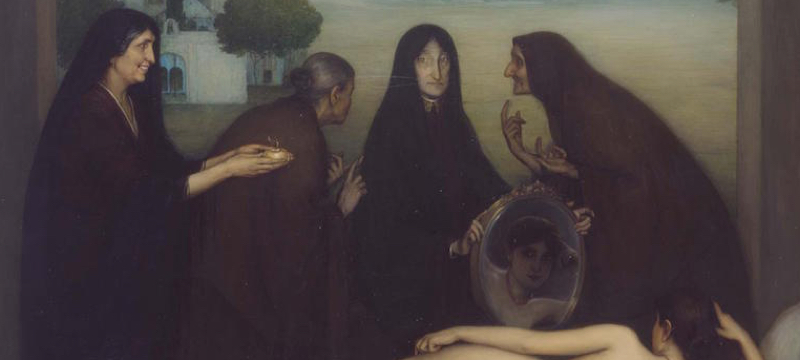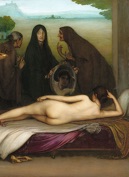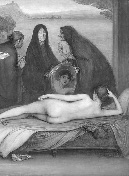Julio Romero de Torres
The Sin

El pecado [The Sin] is a synthesis of Julio Romero de Torres' personal style at the height of his artistic maturity, in which his Andalusian roots were complemented by the influence of French symbolism and the Italian Renaissance.
A naked woman, reclining on her back— in reference to Velázquez's The Toilet of Venus ('The Rokeby Venus') — looks at the viewer through a mirror held by a woman in mourning. She is surrounded by procuresses discussing the conditions of the sin that is about to be committed, symbolised by the apple offered by a fourth woman, the latter with the features of the flamenco singer Carmen Casena. In this work, the artist addresses the theme of prostitution, common in turn-of-the-century painting, but not from a realistic and socially critical perspective, but rather from one of eroticism and allegory. The painting has a poetic and mysterious air, expressed with a symbolist language of stylised figures and an almost dreamlike landscape of cool tones that reveals the castle of Almodóvar and the church of San Hipólito in Córdoba (Spain).
Romero de Torres presented this work alongside La gracia [Grace], with which it forms a pair, at the 1915 Spanish National Fine Arts Exhibition. Both represent one of the classic themes of the Renaissance and of the painter himself: the duality of choices, the virtue-sin dichotomy, sacred love and profane love.
The technique used in El pecado reveals the influence of the Italian Renaissance, typical of the painter's most symbolist period, as can be seen in the construction of colour, as well as in the use of light and shadow through light glazes.
The shadows are built up from the innermost layers and gradually veiled with subtle brushstrokes until the final highlights are achieved. The way the figures and contours are outlined shows the artist's interest in drawing and his attention to nuance. He applied a greater number of brushstrokes to the faces to better define the anatomical features.
The backgrounds and clothing are created using glazes that gradually shape the folds, revealing the weave of the fabric.
The examination with ultraviolet light-induced fluorescence reveals interesting elements of the composition.
On the one hand, it allows us to discern the distribution of the varnish layer on the surface: its different thicknesses, irregularities and method of application. In the visible image, this layer appears homogeneous, although areas of great thickness can be seen on the clothing and chaise longue, which have caused cracks and craquelure. This technique also provides information about the outermost layers of paint and allows them to be differentiated according to the response of their materials to ultraviolet radiation, making it possible to observe the extent of the surface repairs.
Furthermore, the properties of some pigments that exhibit a characteristic fluorescence when exposed to ultraviolet light can be observed, depending on their thickness and the binder used. This is the case with some of the final brushstrokes in the castle area and the white fabric. Although it is not possible to determine the pigment without chemical analysis, this fluorescence is characteristic of zinc white.
Infrared radiation reduces the covering power of certain layers of paint—depending on their composition, method of application, and thickness—allowing the underlying drawing, alterations to the paint layer, and certain restoration treatments to be observed.
In this case, the artist sketched a grid in pencil to define the spaces and arrange the figures, and then drew the elements of the composition. In certain areas, such as the architecture and the chaise longue, he used a ruler to sketch the outline and mark the first lines, before drawing the rest of the elements freehand.
At a later stage, he corrected the initial drawing by defining the shapes with a brush. In some cases, these lines are visible to the naked eye, which shows the prominence of the drawing and the lightness of the brushstrokes in this work. On occasions, he slightly modified the outline of the figures or certain elements such as the apple, even after applying the first layers of colour. For example, he made changes to the figure with its back to the viewer, which was initially slightly in profile, as well as to the definition of the mirror and the placement of the hands holding it.



